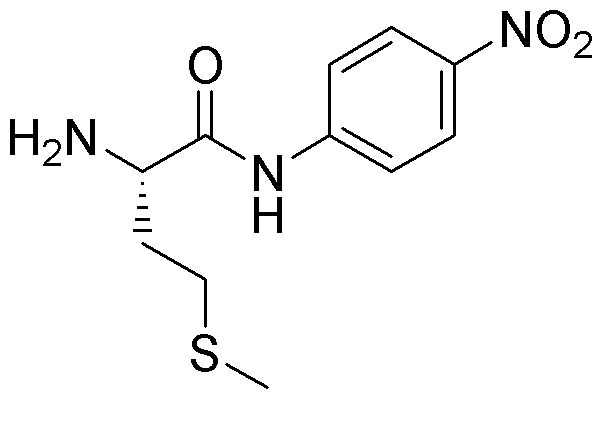L-Methionine 4-nitroanilide is widely utilized in research focused on:
- Biochemical Assays: This compound serves as a substrate in enzyme assays, particularly in studies involving proteases, allowing researchers to measure enzyme activity effectively.
- Pharmaceutical Development: It plays a role in the synthesis of pharmaceutical intermediates, aiding in the development of drugs that target various diseases.
- Analytical Chemistry: Used in chromatographic techniques, it helps in the separation and identification of amino acids and related compounds, enhancing analytical precision.
- Biotechnology: This chemical is important in the production of recombinant proteins, facilitating advancements in genetic engineering and therapeutic protein production.
- Food Industry: It can be utilized as a food additive for its antioxidant properties, contributing to food preservation and safety.
General Information
Properties
Safety and Regulations
Applications
L-Methionine 4-nitroanilide is widely utilized in research focused on:
- Biochemical Assays: This compound serves as a substrate in enzyme assays, particularly in studies involving proteases, allowing researchers to measure enzyme activity effectively.
- Pharmaceutical Development: It plays a role in the synthesis of pharmaceutical intermediates, aiding in the development of drugs that target various diseases.
- Analytical Chemistry: Used in chromatographic techniques, it helps in the separation and identification of amino acids and related compounds, enhancing analytical precision.
- Biotechnology: This chemical is important in the production of recombinant proteins, facilitating advancements in genetic engineering and therapeutic protein production.
- Food Industry: It can be utilized as a food additive for its antioxidant properties, contributing to food preservation and safety.
Documents
Safety Data Sheets (SDS)
The SDS provides comprehensive safety information on handling, storage, and disposal of the product.
Product Specification (PS)
The PS provides a comprehensive breakdown of the product’s properties, including chemical composition, physical state, purity, and storage requirements. It also details acceptable quality ranges and the product's intended applications.
Certificates of Analysis (COA)
Search for Certificates of Analysis (COA) by entering the products Lot Number. Lot and Batch Numbers can be found on a product’s label following the words ‘Lot’ or ‘Batch’.
*Catalog Number
*Lot Number
Certificates Of Origin (COO)
This COO confirms the country where the product was manufactured, and also details the materials and components used in it and whether it is derived from natural, synthetic, or other specific sources. This certificate may be required for customs, trade, and regulatory compliance.
*Catalog Number
*Lot Number
Safety Data Sheets (SDS)
The SDS provides comprehensive safety information on handling, storage, and disposal of the product.
DownloadProduct Specification (PS)
The PS provides a comprehensive breakdown of the product’s properties, including chemical composition, physical state, purity, and storage requirements. It also details acceptable quality ranges and the product's intended applications.
DownloadCertificates of Analysis (COA)
Search for Certificates of Analysis (COA) by entering the products Lot Number. Lot and Batch Numbers can be found on a product’s label following the words ‘Lot’ or ‘Batch’.
*Catalog Number
*Lot Number
Certificates Of Origin (COO)
This COO confirms the country where the product was manufactured, and also details the materials and components used in it and whether it is derived from natural, synthetic, or other specific sources. This certificate may be required for customs, trade, and regulatory compliance.


